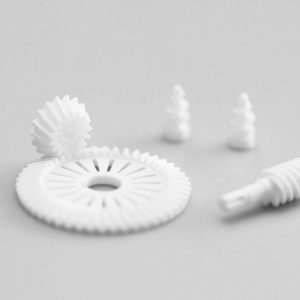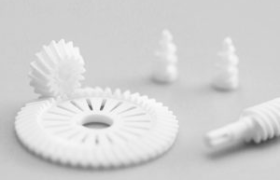High-performance materials for 3D printing are materials that have unique mechanical properties that make them ideal for special end-use applications of high quality.
Polymers like silicone, TPE, TPU, and PEEK, metals like tungsten, copper and scale alloy, and technical or engineering ceramics like Alumina, Zirconia, and Silica are some of our high-performance materials for 3D printing.
All these stand out for their exceptional properties, be it resistance to extreme heat, incredible hardness, biocompatibility, or rubber-like qualities.
High-performance polymers for 3D printing
High performance or engineering polymers are a group of plastic materials that have better mechanical or thermal properties than the more widely used plastics such as Nylon, PS, PP, PE, PET, etc. Although it is by no means a definitive list, we highlight three interesting high-performance polymer materials: PEEK, TPE-TPU, and Silicone.
PEEK
PEEK (polyetheretherketone) is a very strong, heat-resistant, and flame-retardant high-performing engineering thermoplastic that can be used as a lightweight substitute for metal. Parts made of PEEK can be up to 70% lighter than parts made from metal.
It is used in the aerospace, automotive, energy, electronics, and medical industries for the fabrication of rings, caps, and cases. Biocompatible PEEK is available for medical applications such as implants.
PEEK belongs to the polyketone family of polymers (PAEK). However, PEEK can be a fairly expensive material and would typically be used for the production of end parts. High performance PEEK for 3D printing is available as filament for FDM and powder for SLS.
If you are looking for a cheaper alternative material with somewhat similar characteristics have a look at PEI (ULTEM).
3D Printing PEEK, PEI and ULTEM
TPE and TPU
TPE and TPU are thermoplastic elastomers with rubber-like characteristics.
TPU (thermoplastic polyurethane) is a type of thermoplastic elastomer (TPE) and is available in higher hardness grades to achieve parts ranging from soft (rubber-like) to hard (rigid plastic).
Thermoplastic elastomers are used to make rubber-like cases, lids, panels, soles for footwear, etc. They were invented in the 1950s and only recently both materials became available as 3D printable materials for the additive manufacturing industry.
What is the difference between TPE and TPU in 3D printing?
Silicone
Silicone, is a widely used versatile material and the additive manufacturing industry waited for a long time for this material to become available for 3D printing. Silicone is a thermoset polymer and impossible to print with existing printing processes, since they all involve heating and forming of the melted material.
This changed in 2018 when a process was invented that enabled printing with real silicones: DOD or drop on demand, Other breakthroughs followed and silicone 3D printing is now possible. So far only relatively small parts can be printed in silicone, but larger printers are on their way.
Silicone is biocompatible and is widely used for medical applications, but also in other industries.
Silicone printing is fairly costly. A cheaper alternative is TPE, especially for high volume series.
Is 3D Printing with Silicone possible?
High-performance metals for 3D printing
The other main material group used in the additive manufacturing industry are metals. Metals are mostly printed using Selective Laser Melting (SLM) and Direct Metal Laser Sintering (DMLS) but there also metal filaments for FDM machines. Metal powders are available for most commonly used metals like stainless steel, tool steel, aluminum, titanium, nickel, cobalt and chrome alloys. Some metals proved harder to 3D print notably copper and tungsten. Coincidently two metals we want to address alongside a special metal developed for 3D printing called Scalmalloy.
Copper for FDM and SLM
Copper is a popular material loved for its great thermal and electrical conductivity.
Copper filaments for FDM machines have been on the market for some time, but SLM being the favorite method to print metals one would assume that copper powder would be available for 3D printing. However, it was exactly the unique properties of copper that made it unsuitable for laser sintering, because copper does not absorb the laser as well as other metals.
Researchers needed to develop new techniques to make 3D printing with copper possible. The year 2017 saw a breakthrough: copper powders were sintered using a so-called green laser (which is better absorbed by the copper powder) and by adding pre-heating of the copper powder to the process to prevent fracturing. The result is that now high-quality copper parts can be 3D printed.
Incidentally, by 2020 a pure copper filament (99.8% Cu by weight) was developed for FDM industrial metal 3D printing machines, making FDM an option for industrial copper printing as well.
Industrial FDM printing with pure copper
Tungsten and other refractory metals
Tungsten is one of the five refractory metals, molybdenum, tantalum, rhenium and niobium being the others of the group. Refractory metals are extremely high-temperature resistant metals that can withstand temperatures of over 4000° C.
They are hard to manufacture even with traditional manufacturing methods, but are highly desirable for applications that need high heat and impact resistance.
Tungsten carbide, a tungsten composite, and classified as a ceramic, is extremely hard and heat resistant, is used in the aerospace and defense industries among others. Applications include rocket engine nozzles, weapon heads (to penetrate hard surfaces), turbine blades for aircraft (heat resistant), and smaller tools such as saw blades, drill bits, bearings, pistons, and welding equipment.
Tungsten is also used in the medical field because of its radiation shielding properties. The medical industry uses pure tungsten for MRI scanning, collimators and radiation shielding.
Other refractory metals
Of the other refractory metals Molybdenum the most widely used because it is cheaper.
Molybdenum is used in alloys to reinforce steels, like stainless steel.
Tantalum is known for its corrosion resistance and has can be used to make orthopedic implants. It scores higher on cytocompatibility (= not being harmful to a cell) and biocompatibility than titanium.
Rhenium is the rarest and thus most expensive of the refractory metal class. Rhenium alloys are used in electronic components. Niobium has potential applications in aerospace (rocket nozzle) and energy. Refractory metals are a niche market in the overall metal powder industry.
3D printing with tungsten and tungsten carbide
Scalmalloy
Scalmalloy is a high-performance patented metal 3D printing material made from scandium (SC), aluminum (AL), and magnesium (M) alloy (ALLOY).
Initially developed for and by the aerospace industry, but also interesting for other fields. Scalmalloy is already used in the automotive industry (heat exchangers), in robotics (hydraulic manifolds) and motorsports (brackets)
It is lightweight, strong and has high ductility for use in, but not limited to, the aerospace industry. Compared to traditional Aluminum (AlSi10Mg), Scalmalloy is much stronger (stronger than titanium) due to the addition of scandium. Parts 3D printed with Scalmalloy are lightweight, corrosion-resistant and with high ductility.
Scalmalloy: high-performance aluminum for 3D printing
High-performance ceramics for 3D printing
The third groups we want to look at are high-performance ceramics or technical or engineering ceramics. These ceramics have been optimized for industrial applications,
Engineering ceramics are stiff, heat resistant, exhibit poor thermal conductivity, have good electrical insulating properties, are resistant to fracturing, and are biocompatible.
However, these ceramics are notably hard to shape using conventional manufacturing technologies, giving additive manufacturing an additional advantage for working with these materials.
These characteristics allow ceramics to be used in various application areas and branches of industry.
In motorsports, ceramics are used for brake disks, bearings, and exhaust manifolds.
In the medical field, ceramics are used for implants and endoscopic components. The energy industry uses ceramic components because of their great thermal and electrical insulating properties. You will find ceramics in fuel cells, in valve fittings and coil bodies. Ceramics are also great for cutting tools of for laser components. The aerospace industry likes ceramics for its relatively low weight compared to metals.

Alumina, Zirconia, Silica, and other ceramics
The best known are Alumina, Zirconia, and Silica.
Alumina (aluminum oxide) is the most widely used because it is the cheapest.
Zirconia (zirconium dioxide) is used in the dental industry (to make teeth replacements) but also in the aerospace and nuclear industry.
Silica-based ceramics like silicon carbide is the hardest ceramic material (comparable to diamond).
Also of interest are non-oxide high-performance ceramics like Silicon Nitride, Silicon Carbide, Boron Carbide and Aluminium Nitride and metal-ceramic alloy composites.
Ceramic models are made using SLS technology or Binder Jetting using ceramic powders.
Future high-performance materials for 3D printing
As mentioned in the introduction, this is by no means a definitive list of all high-performance materials for 3D printing. As the additive manufacturing industry evolves new materials will be developed. Composites like graphene, bio- and nanomaterials and even so-called 4D materials, that change shape over time, for example shape-memory materials, are new exiting materials with many exiting applications.
Conclusion
High-performance materials for 3D printing are an exciting category of materials in the field of additive manufacturing. These materials stand out for their exceptional properties, from resistance to extreme heat, to incredible hardness, to biocompatibility or exceptional rubberlike qualities. These materials are generally not cheap, they are high-quality materials meant for advanced end-use applications. The list is not exhaustive or definitive as new materials are developed as the additive manufacturing industry evolves.
